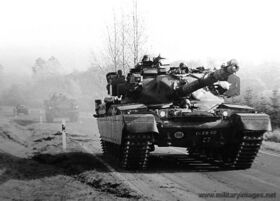Battle of Schwartzgrad (WoLA): Difference between revisions
No edit summary |
m (1 revision imported) |
Latest revision as of 01:14, 23 March 2019
| Battle of Schwartzgrad | |||||||
|---|---|---|---|---|---|---|---|
| Part of the Europan Campaign (1950-1975) of the War of Lorican Aggression | |||||||
 Lucian Chieftain tanks approaching Schwartzgrad | |||||||
| |||||||
| Belligerents | |||||||
|
|
| ||||||
| Commanders and leaders | |||||||
|
Army Group Gallia Army Group South Army Group North Maximillian II Loyalists |
Army Group Norden Army Group Steiner Army Group Süden Army Group West Schwartzgrad Defence Area | ||||||
| Strength | |||||||
|
72 combined divisions 1,575,000 troops 5,750 tanks 1,175 artillery 1,250 aircraft |
40 divisions 750,000-800,000 troops 1,518 tanks and AFVs 575 artillery 750 aircraft 75,000 troops supplanted by the police force, Maximillian Youth, and the Volkssturm | ||||||
| Casualties and losses | |||||||
|
21,750 dead or wounded 250 tanks 75 artillery 100 aircraft |
100,000 dead 200,000 wounded or sick 550,000 captured 1,154 tanks 354 artillery 542 aircraft | ||||||
Template:Campaignbox Europan Campaign (1950-1975)
The Battle of Schwartzgrad, also known as the Fall of Schwartzgrad was the final major offensive of the War of Lorican Aggression.
Following the Paternoster-Elde Offensive of January–February 1945, the Allied Armies had temporarily halted on a line 60 km (37 mi) south of Schwartzgrad and the Allied Armies in the north halted about 50 km north of Schwartzgrad . On 9 March, the East Empire established its defence plan for the city with Operation Tactful. The first defensive preparations at the outskirts of Schwartzgrad were made on 20 March, under the newly appointed commander of Army Group Norden, General Heydrich Konrad.
When the Allied offensive resumed on 16 April, two allied groups attacked Schwartzgrad from the north and south, with the south, consisting of the joint Commonwealth-Federal Armies attacking ahea. Before the main battle in Schwartzgrad commenced, the Allied Army encircled the city after successful battles of the Grausser Heights in the north and the Battle of the Halbe in the south. On 20 April 1975, Maximillian's birthday, the Army Group Gallia led by Commander-in-chief of the Allied Armies Peter Tachibana, advanced from the south, started shelling Berlin's city centre, while Marshal Franklin Victor's Army Group South broke through Army Group West, linked up with Tachibana's Army Group Gallia and advanced towards the western suburbs of Schwartzgrad. On 23 April General Rickard Jaeger assumed command of the forces within Schwartzgrad. The garrison consisted of several depleted and disorganised Kaisermacht and Waffen-SS divisions, along with poorly trained Volksmacht and Maximillian Youth members. Over the course of the next week, the Allied Army gradually took the entire city.
Before the battle was over, Maximillian and several of his followers killed themselves. The city's garrison surrendered on 2 May but fighting continued to the north-west, west, and south-west of the city until the end of the war in Europa on 8 May.